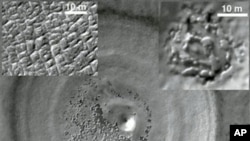A robotic U.S. space probe circling Mars has discovered a massive deposit of frozen carbon dioxide beneath the red planet's southern pole. U.S. space agency scientists say the evidence suggests that our frigid, barren neighbor in the solar system may have been a stormier and wetter world in the distant past than previously believed, and that it could become so again in the future.
Ground-penetrating radar aboard NASA’s unmanned Mars Reconnaissance Orbiter detected the huge underground reservoir of frozen CO2 gas, also known asdry ice.. Scientists already knew there is a perennial cap of dry ice sitting atop the water ice at Mars' south polar region. But this newly found deposit is 30 times thicker than previously estimated.
NASA scientists believe changes in the tilt of Mars' axis every 100,000 years expose the frozen southern pole toward the sun. The warming sunlight triggers a prolonged, but weak, greenhouse effect as huge quantities of the frozen CO2 vaporize, thickening the Martian atmosphere, strengthening winds and causing more frequent and intense dust storms. When the planet eventually tilts its southern pole away from the sun again, the CO2 gas refreezes beneath the surface.
Scientists speculate that the denser, warmer atmosphere of Mars’ distant past could have created more places on the red planet where liquid, flowing water might have existed. They believe the weak greenhouse effect would not have warmed Mars enough, however, to sustain large bodies of liquid water on the surface. The Martian atmosphere is still too thin to prevent liquid water from boiling and evaporating.
Liquid water is considered a key condition for life. NASA scientists say the increased CO2 in the ancient Martian atmosphere, though, would have had very little impact on the possibility of life on Mars.
NASA scientists say the newly found layer of dry ice lies beneath a thin veneer of previously detected frozen water and CO2. It has a volume of between 9,500 and 12,000 cubic kilometers. That is equal to around 80 percent of all the CO2 currently in the thin Martian atmosphere, which is less than 1 percent of the Earth’s.
Research findings on the discovery were published this week in the journal, Science.
Some information for this report was provided by AP and AFP.













